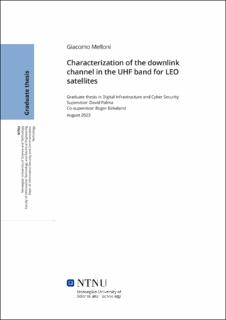| dc.contributor.advisor | Palma, David | |
| dc.contributor.author | Melloni, Giacomo | |
| dc.date.accessioned | 2023-11-07T18:19:34Z | |
| dc.date.available | 2023-11-07T18:19:34Z | |
| dc.date.issued | 2023 | |
| dc.identifier | no.ntnu:inspera:146715749:132714177 | |
| dc.identifier.uri | https://hdl.handle.net/11250/3101218 | |
| dc.description.abstract | Kanalkarakterisering spiller en viktig rolle i ulike telekommunikasjonsdomener, for eksempel mobile radionettverk og satellittkommunikasjon. Det er viktig å forstå hvordan forplantningskanalen oppfører seg for å kunne implementere teknikker for å redusere mediets tids- og stedsavhengighet av radiobølger. Denne avhandlingen tar sikte på å utvikle en metode for å karakterisere nedlink-kanalen (DL), spesielt skreddersydd for LEO-satellitter (Low Earth Orbit) som opererer i UHF-båndet (Ultra High Frequency). Det er utviklet en simulator med en universell arkitektur som er i stand til å gjenskape et bredt spekter av scenarier, med tanke på både satellitt- og bakkestasjonsutstyr. Simulatoren omfatter ulike kanalenheter som kan skape forvrengning i det elektromagnetiske feltet, med hovedfokus på samspillet mellom det overførte signalet og ionosfæren. I tillegg til utviklingen av simulatoren diskuteres ulike metoder for å karakterisere kanalenheter, inkludert kanalsonderteknikken. Som forventet viser det seg at dopplerskiftestimeringen, kanalsonderingen og Faraday-estimeringen er gode metoder som validerer de implementerte kanalenhetene, mens S4-parameteren fungerer under visse forutsetninger. Vi presenterer en HIL-testfase (Hardware In-the-Loop) av disse løsningene ved hjelp av en dedikert testbed. Systemtopologien og de implementerte komponentene beskrives i detalj, sammen med en generell metode for kalibrering og karakterisering av relevante enheter. Analysen avsluttes med en sammenligning av overføringsytelsen til to programvaredefinerte radioenheter (SDR) som inngår i testbedet, og viser at Universal Software Radio Peripheral (USRP)-2901 overgår TOTEM SDR. | |
| dc.description.abstract | Channel characterization plays a vital role in various telecommunication domains, for instance, mobile radio networks and satellite communications. Understanding the behavior of the propagation channel is essential for implementing techniques to mitigate the time and location dependency of the medium on radio waves. This thesis aims at the development of a method for characterizing the Downlink (DL) channel, specifically tailored for Low Earth Orbit (LEO) satellites operating in the Ultra High Frequency (UHF) band. A simulator is designed to accommodate a universal architecture capable of recreating a wide range of scenarios, considering both satellite and ground station equipment. It incorporates various channel entities that can introduce distortion in the electromagnetic field, with a primary focus on the interaction between the transmitted signal and the ionosphere. In addition to the simulator’s development, different methods for characterizing channel entities, including the channel sounder technique, are discussed. As expected, the Doppler shift estimation, the channel sounder and the Faraday estimation offer themselves as good methods, validating the implemented channel entities, while the S4 parameter works under some assumptions. A Hardware In-the-Loop (HIL) testing phase of these solutions is presented, using a dedicated testbed. The system topology and the implemented components are detailed, along with a general method for the calibration and characterization process of relevant entities. Finally, the analysis is completed by comparing the transmission performance of two Software Defined Radio (SDR) devices included in the testbed, showing that the Universal Software Radio Peripheral (USRP)-2901 outperforms the TOTEM SDR. | |
| dc.language | eng | |
| dc.publisher | NTNU | |
| dc.title | Characterization of the downlink channel in the UHF band for LEO satellites | |
| dc.type | Master thesis | |
